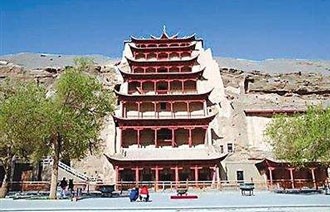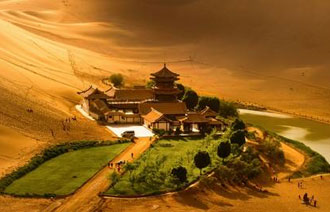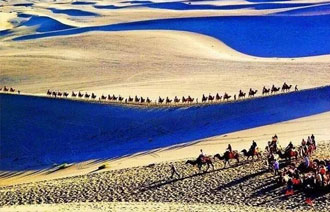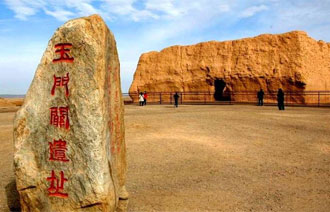Mogao Grottoes
 The Mogao Grottoes (also known as Thousand Buddha Cave), twenty-five kilometers southeast of Dunhuang City, is one of three noted grottoes in China and also the largest and richest treasure trove of stone carvings and mural paintings in China. Carved out along a 1,500-meter precipice, the 492 grottoes stretch from south to north on the eastern slope of Singing Sand Dunes (Mingshashan) and are divided into five levels. They contain 45,000 square meters of murals 2,415 painted statues, and five wooden structures. These murals, if joined together, would cover a length of 30 kilometers.
The Mogao Grottoes (also known as Thousand Buddha Cave), twenty-five kilometers southeast of Dunhuang City, is one of three noted grottoes in China and also the largest and richest treasure trove of stone carvings and mural paintings in China. Carved out along a 1,500-meter precipice, the 492 grottoes stretch from south to north on the eastern slope of Singing Sand Dunes (Mingshashan) and are divided into five levels. They contain 45,000 square meters of murals 2,415 painted statues, and five wooden structures. These murals, if joined together, would cover a length of 30 kilometers.
Singing Sand Dunes and Crescent Moon spring
 Singing Sand Dunes, also called Shensha Hill, is 6 kilometers south of Dunhuang City. The hill is 250 meters high, and as steep as a cliff. Tourists like to climb up the hill bare-footed. At the hill-top they may have a bird's eye view of the sand dunes which encircle a crystal-clear spring shaped like a crescent moon and then slide down from the hill, accompanied by a roaring sound of the moving sand. Crescent Moon Spring is near the northern foot of Singing Sand Dunes in the southern suburbs of Dunhuang City. It is shaped like a crescent moon, and its clear water is surrounded by grass.
Singing Sand Dunes, also called Shensha Hill, is 6 kilometers south of Dunhuang City. The hill is 250 meters high, and as steep as a cliff. Tourists like to climb up the hill bare-footed. At the hill-top they may have a bird's eye view of the sand dunes which encircle a crystal-clear spring shaped like a crescent moon and then slide down from the hill, accompanied by a roaring sound of the moving sand. Crescent Moon Spring is near the northern foot of Singing Sand Dunes in the southern suburbs of Dunhuang City. It is shaped like a crescent moon, and its clear water is surrounded by grass.
Hexi Corridor
 Hexi corridor or Gansu corridor, to the west of the Yellow River, has always been a vital passageway of the Old Silk Road from 2nd C. BC to AD 13th C., along which Dunhuang, Jiuquan, Zhangye and Wuwei were important political, economic, and cultural exchange centers. This is really a narrow but long stretched passage lasting for 1200 kilometers from steep Wushaolin hillside to Xinxinxia gorge at the border of Gansu and Xingiang. There are many fertile oasis surrounded by vast expanse of Gobi-desert, sandwiched in between snow-covered Qilian Mountain to the south and north mountain and deserts to the north.
Hexi corridor or Gansu corridor, to the west of the Yellow River, has always been a vital passageway of the Old Silk Road from 2nd C. BC to AD 13th C., along which Dunhuang, Jiuquan, Zhangye and Wuwei were important political, economic, and cultural exchange centers. This is really a narrow but long stretched passage lasting for 1200 kilometers from steep Wushaolin hillside to Xinxinxia gorge at the border of Gansu and Xingiang. There are many fertile oasis surrounded by vast expanse of Gobi-desert, sandwiched in between snow-covered Qilian Mountain to the south and north mountain and deserts to the north.
Yumen Pass
 The Yumen Pass, situated in the Gobi Desert eighty kilometers northwest of Dunhuang County town, was once one of two critical defensive passes protecting Dunhuang from invasion from the West about two thousand years ago. The desert outside Yumen Pass bears few traces of human activity. At that time, anyone in China wishing to take the Silk Road west (or east into China through Dunhuang) had to pass through this spot. Those familiar with ancient Chinese poetry, may recall a poem written by the renowned Tang Dynasty poet, Wang Zhihuan, describing the unique scenery and atmosphere here.
The Yumen Pass, situated in the Gobi Desert eighty kilometers northwest of Dunhuang County town, was once one of two critical defensive passes protecting Dunhuang from invasion from the West about two thousand years ago. The desert outside Yumen Pass bears few traces of human activity. At that time, anyone in China wishing to take the Silk Road west (or east into China through Dunhuang) had to pass through this spot. Those familiar with ancient Chinese poetry, may recall a poem written by the renowned Tang Dynasty poet, Wang Zhihuan, describing the unique scenery and atmosphere here.
| Dunhuang Attractions List | |

